Pattern-Based Texturing Revisited
Paper URL:
page textures
Images of the paper.
Fig 1: 
Standard pattern-based mapping used for
applying a cellular pattern onto the geometric model of a liver.
Distortions are clearly noticeable.
Fig 3: 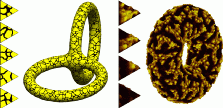
Two cases where unexpected path shapes
appear since the lowest frequency of the texture (i.e. the grain size)
is too close to the sample scale.
Left: A naive set of texture samples designed
to figure cells onto a surface.
Right: A set of procedurally generated volumetric textures.
Fig 5: 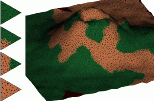
Mountain covered by forest. The location of forest
and ground material is controlled by the values at the nodes of the texture
mesh. These values are `painted' by the user with their probability
attribute (intensity of presence).
Fig 7: 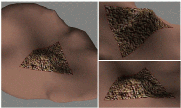
A texture patch mapped onto a curved
region of a geometric model (views from three different viewpoints):
texture distortions remain reasonable.
Fig 8: 
From left to right: the geometric mesh, which is
rendered; the texture mesh, used for tuning the scale
of the texture with respect to the object's geometry; the resulting textured
sphere; the sphere with a finer scale texture.
Fig 9: 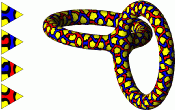
Texture samples drawn by hand, and the resulting
image. Two different edge conditions (red, blue), both symmetric, are used.
Fig 10: 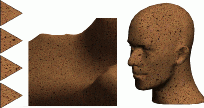
A set of texture samples designed
by interactively editing an image of a sponge (left), and the resulting
textured surface on a terrain and on a face.
Fig 12: 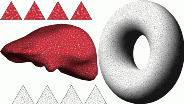
Sets of texture samples generated by our
extension of Worley's synthesis technique,
and the images produced by non-periodically mapping them onto a surface.
Left: A human liver. Right: A china torus.
Fig 14: 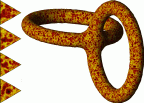
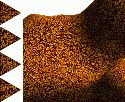
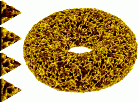
Three sets of texture samples generated by our
extension of Perlin's synthesis technique, and
the images produced by mapping them onto a surface.
In the image on the right, Perlin's texture is used as displacement map,
encoded with an OpenGL implementation of
volumetric textures[13].
Contact
Email :
Fabrice.Neyret@imag.fr_
,
Marie-Paule.Cani@imag.fr_
Adress : EVASION / IMAG - B.P. 53, 38041 Grenoble Cedex 09 - FRANCE










